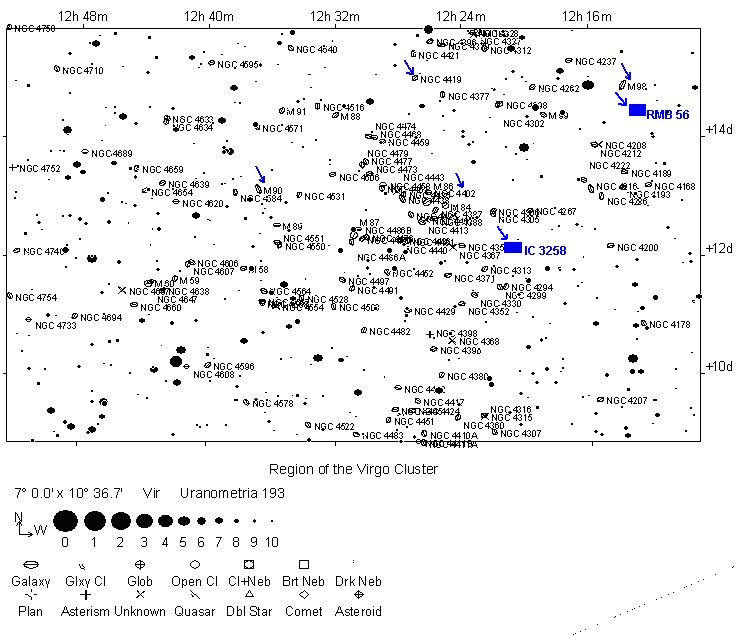
Blueshifted Galaxies in an Expanding “Redshifted” Universe
Virgo Cluster of Galaxies, Constellation: Virgo/Coma
RA: 12h 24m, DEC: 13°
Size: 10° x 12°
Distance » 15 - 20 Mpc (Depends on who you believe) (1 Mpc = 1 megaparsec = 3.26 million light years)
The Virgo Cluster of Galaxies is the largest and nearest large group of galaxies. Centered around RA = 12h, DEC = 13°, some 3,000 galaxies have been identified on photographs taken with the great telescopes, and more than 100 of these galaxies are within reach of amateur sized (6 inch - 10 inch and larger) instruments.
Since the 1950’s controversy surrounded the distance of the Virgo cluster. The average radial velocity for Virgo Cluster members is +1,141 ± 60 km/sec with a velocity dispersion of s = 666 km/sec. Thus there is a wide range of radial velocities in this cluster. Using the redshift relation to derive galaxy distances using the Hubble law, early distances were in the range of 12 Mpc. But the Hubble Constant, H was changing as more detailed investigations of galaxy distances appeared, its range has been 55 - 100 km/sec/Mpc. The great observational astronomer and assistant to Edwin Hubble, Alan Sandage along with Gus Tammann in 1974 - 1975 published a series of papers on their investigation into the Hubble Constant by analyzing many different distance methods to galaxies (Cepheid variables, Bright Blue stars, H II regions, etc.) and comparing them to the known redshifts. These papers involved galaxies in the Virgo Cluster. Sandage and Tammann dervied a global value of the Hubble Constant of 55 ± 5 km/sec/Mpc.
Later investigations using the Hubble Space Telescope and other newer instruments and techniques saw the Hubble Constant rise to 65 - 87 km/sec/Mpc. It seems as if this constant changes every time a new investigation is completed. New values of H change the entire size and age of the Universe !!! Thus the distances to galaxies in the Virgo cluster is very important for cosmology and astronomy since many galaxies in the Virgo cluster are used in the derivation and calibration of the Hubble Constant. Since the vast majority of astronomers believe in the Big Bang with all the galaxies rushing away from each other, the appearance of a blueshifted galaxy would cast a strong doubt on the Big Bang theory, right ?
In 1969 Margaret Burbridge and M. Demoulin made the first announcement of a blushifted object near the center of the Virgo cluster, IC 3258 with a approach velocity of 517 km/sec ! IC 3258 is indeed a galaxy with a visible nucleus and irregular arms. These investigators suggested that IC 3258 could be a member of the Virgo cluster with a high actual space velocity possibly around 1,500 km/sec relative to the average of the cluster. Or it could be a field galaxy with a large random motion. Their speculative idea is that IC 3258 might have been ejected in an outburst from one of the radio galaxies in the cluster. IC 3258 is just 32' from M84 and 104' from M87, and these Messier galaxies are thought to be responsible for the ejection of several quasars in the area according to Halton Arp.
Several blueshifted galaxies appear in the direction of the Virgo cluster. These include:
Object Radial Velocity (VR)
M90 -383 km/sec
M86 -340 km/sec
M98 -142 km/sec
IC 3258 -517 km/sec
NGC 4419 -342 km/sec
RMB 56 -327 km/sec
Are we to assume that these galaxies cast doubts on the expanding Universe theory ? Not necessarily so. Some theories about the blueshifts are:
1) The expansion of the Universe is not uniform, the Virgo cluster/cloud and the Local Group may have large individual space motions relative to the general expansion.
2) The observed VR could be due to large random motions of the galaxies within the cluster, possibly due in part to a general rotation of the cluster.
3) These blueshifted objects could have been ejected or may be escaping from the cluster and could actually be foreground objects. It would seem likely that the blueshifted objects M86, M90 and M98 are indeed closer since their apparent sizes are larger.
4) In the case of RMB 56, in 1973 Searle, et.al suggested that cells of H II regions on the time scale of 108 (100 million) years were “flashing”. A detailed investigation of RMB 56 showed an active H II region near its center (£ 200 pc diameter) that might be “flashing”. The flashing process is not yet understood and is probably linked to a period of intense star formation. However “flashing” is only expected to increase the brightness of a galaxy by perhaps 1 magnitude causing it to appear bluer and may not necessarily affect the Doppler shift. But are these flashing H II regions undergoing high motion, thus contaminating the host galaxy spectrum?
5) Gravitational redshifts: could cause observed redshifts to give the illusion that an object is receding away, when in fact an unusually high mass is causing the redshift. This is predicted by General Relativity.
A diagram of the region of the Virgo Cluster is shown from MEGASTAR below. The blueshifted objects are marked with arrows.

Figure 1. In this chart of galaxies around the Virgo Cluster, arrows indicate blueshifted galaxies.
REFERENCES
Burbidge, E.M. Demoulin, M.H., 1969, “IC 3258, A Small Extragalactic Object with a Blueshift”, Astrophysical Journal, 157, L155
Burnham, R., Burnham’s Celestial Handbook, Dover Publications, 1976, p. 2074 - 2086
Kinman, T.D. 1977, Compact Blueshifted Galaxy RMB 56 (1216+141), Astronomical Journal, 82, p. 879
Parker, S. B.,1983, McGraw Hill Encyclopedia of Astronomy, McGraw Hill Press, p.392, 414.
Tammann, G.A., 1972, Remarks on the Radial Velocities of Galaxies in the Virgo Cluster, Astronomy & Astrophysics, 21, p. 355
Tully, R. B., 1988, Nearby Galaxies Catalog, Cambridge University Press, (Also Astronomical Data Center (ADC) catalog #7145)